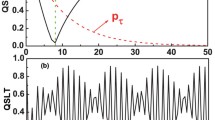Abstract
If an initial state \(|\psi_{ \scriptscriptstyle{\mathrm{I}} } \rangle \) and a final state \(|\psi_{ \scriptscriptstyle{\mathrm{F}} } \rangle \) are given, then there exist many Hamiltonians under whose action \(|\psi_{ \scriptscriptstyle{\mathrm{I}} } \rangle \) evolves into \(|\psi_{ \scriptscriptstyle{\mathrm{F}} } \rangle \). In this case, the problem of the transition of \(|\psi_{ \scriptscriptstyle{\mathrm{I}} } \rangle \) to \(|\psi_{ \scriptscriptstyle{\mathrm{F}} } \rangle \) in the least time is very interesting. It was previously shown that for a Hermitian Hamiltonian, there is an optimum evolution time if \(|\psi_{ \scriptscriptstyle{\mathrm{I}} } \rangle \) and \(|\psi_{ \scriptscriptstyle{\mathrm{F}} } \rangle \) are orthogonal. But for a \(PT\)-symmetric Hamiltonian, this time can be arbitrarily small, which seems amazing. We discuss the optimum time evolution for pseudo-Hermitian Hamiltonians and obtain a lower bound for the evolution time under the condition that the Hamiltonian is bounded. The optimum evolution time can be attained in the case where two quantum states are orthogonal with respect to some inner product. The results in the Hermitian and pseudo-Hermitian cases coincide if the evolution is unitary with some well-defined inner product. We also analyze two previously studied examples and find that they are consistent with our theory. In addition, we give some explanations of our results with two examples.
Similar content being viewed by others
REFERENCES
A. Carlini, A. Hosoya, T. Koike, and Y. Okudaira, “Time-optimal quantum evolution,” Phys. Rev. Lett., 96, 060503 (2006); arXiv:quant-ph/0511039v1 (2005).
C. M. Bender and D. C. Brody, “Optimal time evolution for Hermitian and non-Hermitian Hamiltonians,” in: Time in Quantum Mechanics, 2 (Lect. Notes Phys., Vol. 789, G. Muga, A. Ruschhaupt, and A. del Campo, eds.), Springer, Berlin (2009), pp. 341–361; arXiv:0808.1823v1 [quant-ph]. (2008)
D. C. Brody and D. W. Hook, “On optimum Hamiltonians for state transformations,” J. Phys. : Math. Gen., 39, L167–L170 (2006).
J. Anandan and Y. Aharonov, “Geometry of quantum evolution,” Phys. Rev. Lett., 65, 1697–1700 (1990).
S. Deffner and E. Lutz, “Energy-time uncertainty relation for driven quantum systems,” J. Phys. : Math. Theor., 46, 335302 (2013).
S. Kobayashi and K. Nomizu, Foundations of Differential Geometry, 2, John Wiley and Sons, New York (1969).
C. M. Bender and S. Boettcher, “Real spectra in non-Hermitian Hamiltonians having \(\mathcal{PT}\) symmetry,” Phys. Rev. Lett., 80, 5243–5246 (1998).
C. F. de Morisson Faria and A. Fring, “Time evolution of non-Hermitian Hamiltonian systems,” J. Phys. : Math. Gen., 39, 9269–9289 (2006).
S. Dey, A. Fring, and L. Gouba, “\(\mathcal{PT}\)-symmetric noncommutative spaces with minimal volume uncertainty relations,” J. Phys. : Math. Theor., 45, 385302 (2012).
A. Mostafazadeh, “Pseudo-Hermiticity and generalized \(PT\)- and \(CPT\)-symmetries,” J. Math. Phys., 44, 974–989 (2003); arXiv:math-ph/0209018v3 (2002).
S. Albeverio, A. K. Motovilov, and A. A. Shkalikov, “Bounds on variation of spectral subspace under \(J\)-self-adjoint perturbation,” Integr. Equ. Oper. Theory, 64, 455–486 (2009).
E. Caliceti and S. Graffi, “Reality and non-reality of the spectrum of \(\mathcal{PT}\)-symmetric operators: Operator-theoretic criteria,” Pramana J. Phys., 73, 241–249 (2009).
C. M. Bender, “Making sense of non-Hermitian Hamiltonians,” Rep. Prog. Phys., 70, 947–1018 (2007); arXiv:hep-th/0703096v1 (2007).
H. X. Cao, Z. H. Guo, and Z. L. Chen, “CPT-frames for non-Hermitian Hamiltonians,” Commun. Theor. Phys., 60, 328–334 (2013).
Z. H. Guo, H. X. Cao, and L. Lu, “Adiabatic approximation in \(PT\)-symmetric quantum mechanics,” Sci. China Phys. Mech. Astron., 57, 1835–1839 (2014).
W. Wang, H. Cao, and Z. Chen, “Adiabatic approximation for the evolution generated by an \(A\)-uniformly pseudo-Hermitian Hamiltonian,” Theor. Math. Phys., 192, 1365–1379 (2017).
C. M. Bender, D. C. Brody, H. F. Jones, and B. K. Meister, “Faster than Hermitian quantum mechanics,” Phys. Rev. Lett., 98, 040403 (2007); arXiv:quant-ph/0609032v1 (2006).
A. Mostafazadeh, “Quantum brachistichrone problem and the geometry of the state space in pseudo-Hermitian quantum mechanics,” Phys. Rev. Lett., 99, 130502 (2007); arXiv:0706.3844v4 [quant-ph] (2007).
P. E. G. Assis and A. Fring, “The quantum brachistochrone problem for non-Hermitian Hamiltonians,” J. Phys. : Math. Theor., 41, 244002 (2008).
A. Mostafazadeh, “Exact \(PT\)-symmetry is equivalent to Hermiticity,” J. Phys. : Math. Theor., 36, 7081–7091 (2003); arXiv:quant-ph/0304080v2 (2003).
S. Lee, “\(PT\)-symmetric quantum mechanics is a Hermitian quantum mechanics,” arXiv:1312.7738v5 [quant-ph] (2013).
A. Mostafazadeh, “Pseudo-Hermiticity versus \(PT\) symmetry: The necessary condition for the reality of the spectrum of a non-Hermitian Hamiltonian,” J. Math. Phys., 43, 205–214 (2002); arXiv:math-ph/0107001v3 (2001).
R. Zhang, H. Qin, and J. Xiao, “PT-symmetry entails pseudo-Hermiticity regardless of diagonalizability,” J. Math. Phys., 61, 012101 (2020).
Y. N. Dou and H. K. Du, “Generalizations of the Heisenberg and Schrödinger uncertainty relations,” J. Math. Phys., 54, 103508 (2013).
D. C. Brody, “Elementary derivation of passage times,” J. Phys. : Math. Gen., 36, 5587–5593 (2003); arXiv:quant-ph/0302067v1 (2003).
Acknowledgments
One of the authors (W. H. W.) thanks Professor Andreas Fring for the extensive discussion about the Berry phase, is grateful to Julia Cen and Thomas Frith for the discussions, and also thanks City University London for the warm hospitality.
Funding
This research is supported by the National Natural Science Foundation of China (Grant Nos. 11871318, 11771009, 11701011, 11601300, 11571213, and 61602291), the FRF for the Central Universities (Grant No. GK202003093), and the State Scholarship Fund of China Scholarship Council.
Author information
Authors and Affiliations
Corresponding author
Ethics declarations
The authors declare no conflicts of interest.
Rights and permissions
About this article
Cite this article
Wang, W.H., Chen, Z.L., Song, Y. et al. Optimal time evolution for pseudo-Hermitian Hamiltonians. Theor Math Phys 204, 1020–1032 (2020). https://doi.org/10.1134/S0040577920080048
Received:
Revised:
Accepted:
Published:
Issue Date:
DOI: https://doi.org/10.1134/S0040577920080048




